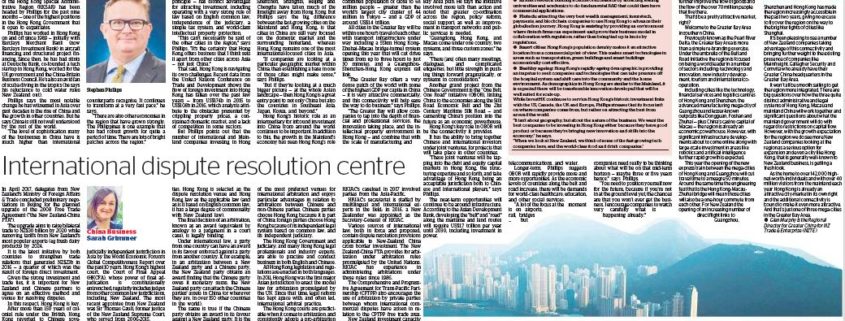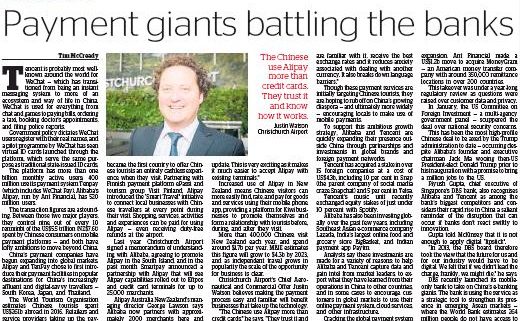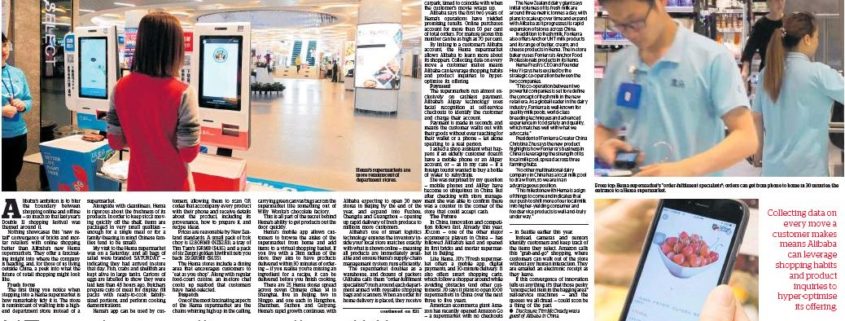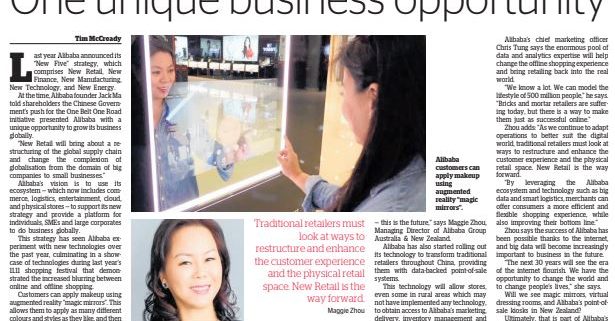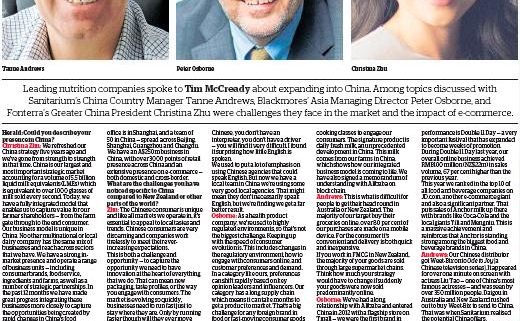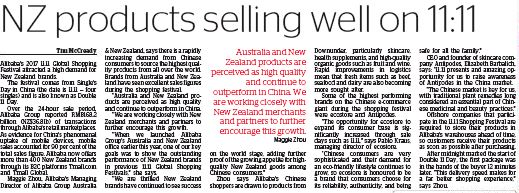China Business: A gateway for global investors (NZ Herald)
Tim McCready spoke to Stephen Phillips, Director General at InvestHK about Hong Kong’s role in attracting foreign direct investment into Asia.
When asked what makes Hong Kong the best place in the world to invest, Director General at Invest Hong Kong (InvestHK) Stephen Phillips points to its geographic positioning in the heart of Asia, the fusion of Eastern and Western culture, the melting pot of highly educated talent, and its proximity and connection to Mainland China.
The investment promotion agency of the Hong Kong Special Administrative Region (HKSAR) has been headed by Phillips for the past nine months — one of the highest positions in the Hong Kong Government that is open to expatriates.
Phillips has worked in Hong Kong on and off since 1989 — initially with Barclays Merchant Bank (now Barclays Investment Bank) in aircraft financing and structured project financing. Since then, he has had stints at Deutsche Bank, co-founded a tech startup in Hong Kong, worked for the UK government and the China-Britain Business Council. He’s also an avid fan of scuba diving in the tropics (he says his reluctance to cold water rules New Zealand out).
Phillips says the most notable change he has witnessed in Asia over past decades is the rise of China and the growth in other countries. But he says China is still not well understood by the rest of the world.
“The level of sophistication many of the businesses in China have is much higher than international counterparts recognise. It continues to transform at a very fast pace,” he says.
“There are also other economies in the region that have grown strongly. The Philippines is one example that has had robust growth for quite a period of time. There are lots of bright patches across the region.”
Hong Kong — which is part of China under the “one country, two systems” principle — has distinct advantages for attracting investment, including operating with a very strong rule of law based on English common law, independence of the judiciary, a simple tax system, and world-class intellectual property protection.
“This can’t necessarily be said of the other cities in the region,” says Phillips. “It’s the certainty that Hong Kong offers business that I think sets it apart from other cities across Asia — not just China.”
That said, Hong Kong is navigating its own challenges. Recent data from the United Nations Conference on Trade and Development shows the flow of foreign investment into Hong Kong has fallen over the past few years — from US$174b in 2015 to US$108b in 2016, which analysts attribute to the obstacles presented by crippling property prices, a constrained domestic market, and a lack of competition in some sectors.
But Phillips points out that the number of international and Mainland companies investing in Hong Kong continues to track upwards, and that capital flows can be misleading.
“At a fundamental level, from what we see, investment going into Hong Kong — where people are doing business and generating jobs — continues to track upwards. Tracking capital figures on a year-on-year basis can look a bit bumpy,” he says.
The transformation and growth in cities across China is remarkable on a global scale, and in recent years Shenzhen, Shanghai, Beijing and Chengdu have taken much of the limelight away from Hong Kong. But Phillips says the big difference between the fast-growing cities on the Mainland and Hong Kong, is that cities in China are still very focused on the domestic market and the surrounding hinterland, whereas Hong Kong remains one of the most international-focused cities in Asia.
“If companies are looking at a particular geographic market within China, then establishing a base in one of those cities might make sense,” says Phillips.
“But if they’re looking at a much bigger picture — at the whole Asian landscape — then Hong Kong is a great entry point to not only China but also the countries in Southeast Asia, Japan, Korea, and beyond.”
Hong Kong’s historic role as an intermediary for inbound investment into China from around the world continues to be important. In addition to this, the growth in the Mainland’s economy has seen Hong Kong’s role as an outward stepping stone for Chinese companies to access a global market become increasingly important for InvestHK.
China’s answer to Silicon Valley
The ambitious Greater Bay Area initiative has been put in place by the Chinese Government, aiming to link Hong Kong, Macau, and nine cities in Guangdong Province in an integrated economic and business cluster.
The 11 cities in the region have a combined population of close to 68 million people — greater than the world’s largest city cluster of 44 million in Tokyo — and a GDP of around US$1.4 trillion.
All cities in the Greater Bay will be within one hour’s travel of each other, with transport infrastructure under way including a 55km Hong Kong–Zhuhai–Macau bridge-tunnel system opening this year that will cut drive times from up to three hours to just 30 minutes, and a Guangzhou–Shenzhen–Hong Kong express rail link.
“The Greater Bay offers a very dense patch of the world with some of the highest GDP per capita in China — it is very attractive commercially, and this connectivity will help ease the way to do business,” says Phillips.
“The Greater Bay will allow companies to tap into the depth of financial and professional services, the innovation taking place, and the intellectual property environment in Hong Kong — and combine that with the scale of manufacturing and innovation within Guangdong.
“You can do R&D in Hong Kong, prototype in Shenzhen, and then take things to market very quickly as well. We will see this part of the world develop into a major financial and innovation centre.”
However, there is still a lot to work to do. Wang Rong — a top Guangdong official — was this month unusually critical of his exchanges with Hong Kong counterparts about the Greater Bay Area plan. He says the initiative involved more talk than action and noted that greater co-ordination across the region, policy reform, social support, as well as improvement in transport networks and public services is needed.
“Guangdong, Hong Kong, and Macau come under one country, two systems, and three custom zones,” he says.
“There [are] often many meetings, dialogues, and complicated etiquettes, but little strength in pushing things forward pragmatically, or systems in consolidation.”
Another grand project from the Chinese Government is the “One Belt, One Road” initiative (OBOR), linking China to the economies along the Silk Road Economic Belt and the 21st Century Maritime Silk Road — and cementing China’s position into the future as an economic powerhouse.
Hong Kong’s key role in OBOR will be the connectivity it provides.
It has the ability to bring together Chinese and international investors under joint ventures, for projects that will take place in other countries.
“These joint ventures will be tapping into the debt and equity capital markets in Hong Kong, the structuring expertise and so forth, and take advantage of Hong Kong being an acceptable jurisdiction both to Chinese and international players,” says Phillips.
The near-term opportunities will continue to be around infrastructure. According to the Asian Development Bank, developing the “belt” and “road” along the maritime and land routes will require US$1.7 trillion per year until 2030, including investment in power, telecommunications, and water.
Longer-term, Phillips suggests OBOR will rapidly provide more and more opportunities.
As the economic levels of countries along the belt and road increase, there will be demands for world-class healthcare, education, and other social services.
“A lot of the focus at the moment is on airports, rail, bridges … but companies need really to be thinking about what will be on that mid-term horizon — maybe three or five years hence,” says Phillips.
“You need to position yourself now for the future, because if you’re not in at the ground level yet, the chances are that you won’t ever get the business. I encourage companies to watch very carefully what is happening already.”
A FOCUS ON INNOVATION
Hong Kong’s support for incubators, accelerators and funding initiatives over the past few years has seen the startup ecosystem skyrocket. Between 2015 and 2016 the number of startups grew 24 per cent, and the number of staff working in startups ballooned 41 per cent.
InvestHK’s latest survey shows that 35 per cent of founders have come from overseas or Mainland China, and recent policy changes from the Government demonstrate Hong Kong’s commitment to continue to attract the best global talent, businesses, and academics in key sectors.
In particular, areas of high priority for Hong Kong include:
- AI and robotics: building a centre of excellence by attracting leading universities and academics to do fundamental R&D that could then have commercial applications.
- Fintech: attracting the very best wealth management, insuretech, payments, and blockchain companies to use Hong Kong to advance their globalisation journey. Hong Kong is assisting by providing an environment where fintech firms can experiment and prove their business model in collaboration with regulators, rather than being tied up in knots by regulations.
- Smart cities: Hong Kong’s population density makes it an attractive location from a commercial point of view. This makes smart technologies in areas such as transportation, green buildings and smart buildings economically cost effective.
- Healthy ageing: Hong Kong’s rapidly ageing demographic is providing an impetus to seek companies and technologies that can take pressure off the hospital system and shift care into the community and the home environment. As demographics in Hong Kong are similar to the Mainland, it is expected there will be transferrable innovation developed that will be well suited for scale-up.
While InvestHK continues to service Hong Kong’s historic investment links with the US, Canada, the UK and Europe, Phillips stresses that its focus isn’t on where companies come from, but rather on attracting the best from around the world.
“It isn’t about geography, but about the nature of the business. We want the best companies to be investing in Hong Kong either because they have good product or because they’re bringing new innovation and skills into the economy,” he says.
“When we look at New Zealand, we think of some of the fast-growing tech companies here, and the world-class food and drink companies.”

